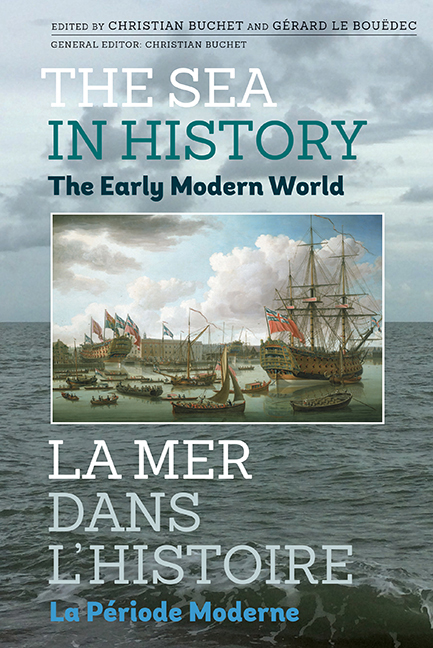Book contents
- Frontmatter
- Contents
- List of Illustrations
- List of Contributors
- Introduction générale et remerciements par
- General introduction and acknowledgements
- Introduction (français)
- Introduction (English)
- LA RÉUSSITE PAR LA MER:La reussite par la mer des territoires et des communautés littorales
- La construction d'un espace mondial: La circulation maritime et les ports
- La forte croissance de l'économie des pêches et des échanges
- Pêches méditerranéennes et développement de l'économie maritime
- The development of fishing fleets in the North Atlantic Ocean
- Les pêches morutières, terre-neuvières, baleinières en Amérique du Nord
- Salt trade in Europe and the development of salt fleets
- Les flottes du vin en Europe: transporter et négocier une marchandise à risque, XVIe-XVIIIe siècles
- L'affirmation de l'Europe baltique et scandinave au XVIIIe siècle
- Sugar and the slave trade in the development of Atlantic maritime trade
- Les flottes négrières de la traite atlantique
- Production and export of tobacco: the development of Atlantic maritime commerce
- Asia–Europe trade: the demand for Asian goods and long-distance shipping from the Indian Ocean and South China Sea
- Les acteurs de la dynamique maritime
- LA PUISSANCE MARITIME INSTRUMENT DE LA PUISSANCE POLITIQUE ET D'UNE STRATÉGIE GLOBALE DE RAYONNEMENT VOIRE DE DOMINATION: Les puissances maritimes occidentales
- L'océan Indien, entre convoitises et indifférences
- Les puissances maritimes asiatiques
- L'Afrique
- La politique maritime et l'idéologie
- Mer et développement technologique
- Développement maritime et maîtrise économique et financière
- Développement maritime et maîtrise organisationnelle
- Conclusion (français)
- Conclusion (English)
- Conclusion générale par
- General conclusion by
- Miscellaneous Endmatter
- Miscellaneous Endmatter
Asia–Europe trade: the demand for Asian goods and long-distance shipping from the Indian Ocean and South China Sea
from La forte croissance de l'économie des pêches et des échanges
Published online by Cambridge University Press: 11 May 2017
- Frontmatter
- Contents
- List of Illustrations
- List of Contributors
- Introduction générale et remerciements par
- General introduction and acknowledgements
- Introduction (français)
- Introduction (English)
- LA RÉUSSITE PAR LA MER:La reussite par la mer des territoires et des communautés littorales
- La construction d'un espace mondial: La circulation maritime et les ports
- La forte croissance de l'économie des pêches et des échanges
- Pêches méditerranéennes et développement de l'économie maritime
- The development of fishing fleets in the North Atlantic Ocean
- Les pêches morutières, terre-neuvières, baleinières en Amérique du Nord
- Salt trade in Europe and the development of salt fleets
- Les flottes du vin en Europe: transporter et négocier une marchandise à risque, XVIe-XVIIIe siècles
- L'affirmation de l'Europe baltique et scandinave au XVIIIe siècle
- Sugar and the slave trade in the development of Atlantic maritime trade
- Les flottes négrières de la traite atlantique
- Production and export of tobacco: the development of Atlantic maritime commerce
- Asia–Europe trade: the demand for Asian goods and long-distance shipping from the Indian Ocean and South China Sea
- Les acteurs de la dynamique maritime
- LA PUISSANCE MARITIME INSTRUMENT DE LA PUISSANCE POLITIQUE ET D'UNE STRATÉGIE GLOBALE DE RAYONNEMENT VOIRE DE DOMINATION: Les puissances maritimes occidentales
- L'océan Indien, entre convoitises et indifférences
- Les puissances maritimes asiatiques
- L'Afrique
- La politique maritime et l'idéologie
- Mer et développement technologique
- Développement maritime et maîtrise économique et financière
- Développement maritime et maîtrise organisationnelle
- Conclusion (français)
- Conclusion (English)
- Conclusion générale par
- General conclusion by
- Miscellaneous Endmatter
- Miscellaneous Endmatter
Summary
ABSTRACT. The maritime trade in Asian luxury and manufactured goods reconfigured the material cultures of the Islamic, European and Atlantic worlds during the early modern period. The history of the trade and shipping of these goods was a global phenomenon, not one confined to the Indian Ocean. Historians are now seeking the connections across the Atlantic and Pacific Oceans, the Indian Ocean and the South China Seas. Europeans first joined Asian commercial routes as minor players, then developed powerful trading companies and a naval infrastructure to dominate trade. The printed cotton textiles and porcelain they brought with them stimulated new manufacture and industrialization in Europe, but not Asia, and tea drinking became embedded in European and Atlantic world cultures of sociability.
RÉSUMÉ. Le commerce maritime des produits asiatiques de luxe et manufacturés a reconfiguré les cultures matérielles des mondes islamique, européen et atlantique au début de la période moderne. L'histoire du commerce et de l'expédition de ces marchandises a été un phénomène mondial, qui ne fut pas limité au seul océan Indien. Les historiens cherchent aujourd'hui à établir des liens entre les océans Atlantique et Pacifique, l'océan Indien et les mers de Chine du Sud. Les Européens ont d'abord rejoint les routes commerciales asiatiques en tant qu'acteurs mineurs, puis ont développé de puissantes sociétés commerciales et une infrastructure navale pour dominer le commerce. Les tissus imprimés en coton et la porcelaine apportés ont stimulé la fabrication et l'industrialisation en Europe, mais pas en Asie, et la consommation de thé a été intégrée dans les cultures européennes et atlantiques de sociabilité.
EARLY TRADE BETWEEN ASIA AND EUROPE
The long-distance maritime trade between Asia and Europe from the early sixteenth century transformed the commodity and material culture of Europe. It also deeply affected Asian maritime trade and coastal and hinterland regions servicing this trade. This Asia–Europe trade built on a much earlier integration of the Indian Ocean world with the South China Sea. Critical to the vitality of this Asian–European trading world were the close connections with Atlantic and Pacific Ocean maritime worlds as silver flowed from Potosí and Zacatecas to Acapulco and Manila, and from thence to Europe and China.
- Type
- Chapter
- Information
- The Sea in History - The Early Modern World , pp. 308 - 318Publisher: Boydell & BrewerPrint publication year: 2017



